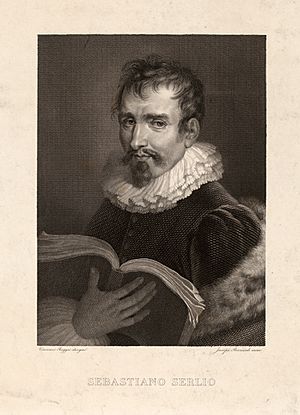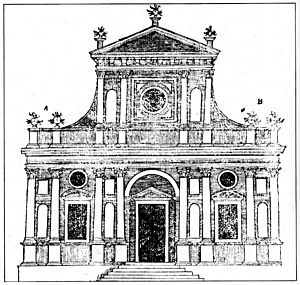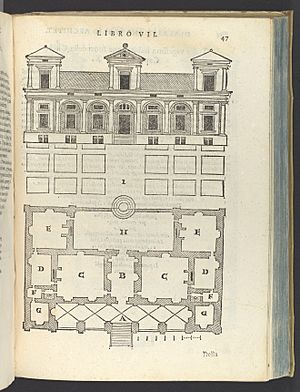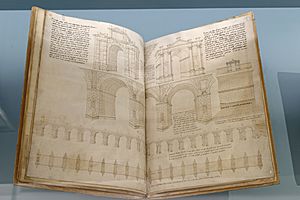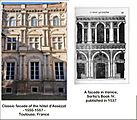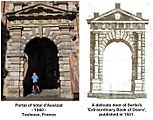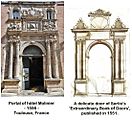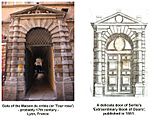Sebastiano Serlio facts for kids
Sebastiano Serlio (born September 6, 1475 – died around 1554) was an Italian architect. He was known for his unique style, called Mannerism. Serlio was part of a team of Italian artists who helped build the famous Palace of Fontainebleau in France.
He became very famous for his books on architecture. These books helped set the rules for how to use classical orders in buildings. These orders are like different styles of columns and decorations from ancient Greece and Rome. His most important work was called I sette libri dell'architettura, which means "Seven Books of Architecture."
Contents
Life of Sebastiano Serlio
Sebastiano Serlio was born in a city called Bologna in Italy. In 1514, he moved to Rome and started working with a well-known architect named Baldassare Peruzzi. Serlio learned a lot from Peruzzi.
However, in 1527, Rome was attacked in an event known as the Sack of Rome. This event stopped all building projects for a while. Like Peruzzi, Serlio first started his career as a painter.
After the Sack of Rome, Serlio moved to Venice. He lived there from about 1527 until the early 1540s. Even though he lived there for many years, he didn't build many famous structures in Venice itself.
Designing Church Buildings
Serlio created a very important design for the front of churches. He made a simpler, more classical version of a style that was already being used. This style involved a tall main section with lower sections on the sides. It helped make Gothic-style churches look more classical.
This idea was first seen in Alberti's Santa Maria Novella church in Florence around 1458. Serlio's design, published as a woodcut print, made this idea available to many architects. He also worked as an engineer, designing strong walls for protection, called fortifications.
Working in France
Serlio's books, more than his actual buildings, caught the eye of King François I of France. The king invited Serlio to France to help with the design and decoration of the Palace of Fontainebleau. A group of talented Italian designers and artists, including Giacomo Barozzi da Vignola and Benvenuto Cellini, also worked there.
Serlio took on some private building projects in France. The only one that still looks much like his original design is the Château d'Ancy-le-Franc. This castle was built around 1546 in Burgundy, France.
Sebastiano Serlio passed away around 1554 in Fontainebleau. He spent his last years living in Lyon.
Serlio's Architecture Books
Serlio's most famous work is Tutte l'opere d'architettura et prospetiva. This means "All the Works of Architecture and Perspective." It was a very practical guide for architects.
Before Serlio, Leon Battista Alberti wrote the first architecture book during the Renaissance. But Alberti's book had no pictures and was written in Latin. It was meant more for educated people and rich sponsors than for builders.
Serlio changed this by adding many high-quality pictures to his text. He wrote his books in Italian, and some were even published with both Italian and French text side-by-side. His books were made especially for architects, builders, and craftspeople.
The Eight Books
Serlio's work is made up of eight books. One of these books (the sixth) was lost for many centuries. The eighth book was only published much later. The first five books cover important topics like geometry, perspective, and the architecture of Ancient Rome. They also explain the different orders of columns and how to design churches.
The sixth book shows designs for homes, from simple peasant huts to grand royal palaces. It's a unique record of different types of Renaissance houses. It even includes designs for strong fortresses and Serlio's plans for the Louvre palace, which were never built.
The seventh book deals with common design problems that earlier writers didn't cover. For example, it shows how to update or "restore" Gothic building fronts using old Roman ideas of symmetry and proportion.
The eighth book is called "Castrametation of the Romans. It describes how ancient Roman army camps were set up, based on writings by Polybius. It also includes designs for a military city and a huge bridge that was supposedly built by Emperor Trajan. This book is a mix of fantasy and archaeology. It is different from Serlio's other more practical works.
Serlio gave credit to his teacher, Baldassare Peruzzi, for much of the content in Book IV. He said, "As for all the pleasant things which you will find in this book, you should give the credit not to me but to my teacher, Baldassare Peruzzi from Siena..."
Publication History
Serlio started working on his books at least ten years before the first one was published in 1537. He had planned for seven books. Even though he finished all seven, only the first five were published during his lifetime. The sixth book remained as a handwritten document until the 20th century.
He also wrote two extra books. One was the Extraordinary Book of Doors, which was the last book he saw printed. The other was On Polybius' Castrametation, about Roman military camps. It's not clear if this book was fully finished or how it was meant to fit with the others.
| How Serlio's books were published, compared to his own numbering: | ||||||||||
| 4 | 1537 Venice | On the Five Styles of Buildings | ||||||||
| 3 | 1540 Venice | On Antiquities | ||||||||
| 1 | 2 | 1545 Paris | On Geometry, On Perspective | |||||||
| 5 | 1547 Paris | On Temples | ||||||||
| X | 1551 Lyon | Extraordinary Book of Doors | ||||||||
| 7 | 1575 Frankfurt | On Situations (published after his death) | ||||||||
| 6 | 1966 Milan | On Habitations (published after his death; a copy of the original manuscript) | ||||||||
| Y | 1994 Milan | On Polybius' Castrametation (published after his death) | ||||||||
Serlio didn't give a single title to his entire collection of works. Sometimes it was called General Rules of Architecture. Other times, people referred to it as the Five or Seven Books on Architecture. Often, it's simply known as Serlio's Architettura. The full collection of all nine books was finally published in English between 1996 and 2001.
Theater Designs
The last few pages of Serlio's second book, "On Perspective," are very interesting. They show three different types of theater scenes: funny, sad, and satirical. They also include a stage plan and a cross-section view of a theater. These designs were very important and had a big impact on how theaters were built during the Renaissance.
Serlio was also one of the first people to use the phrase fine arts. He wrote about Pope Leo X, calling him "father and patron of all fine arts and all good artists."
Serlio's Impact on Architecture
Serlio's books were very important in France, the Netherlands, and England. They helped spread the Italian Renaissance style of architecture. His drawings of Roman buildings gave architects many ideas for classical designs, and these drawings were often reprinted.
Just five years after Serlio's first book was published, a scholar from Flanders named Pieter Coecke van Aelst created his own versions of Book IV. These were published in Flemish, German, and French. Serlio thought these versions were unauthorized and not as good as his own. However, they helped spread his ideas even further.
Coecke van Aelst's student, Hans Vredeman de Vries, continued to spread Serlio's style and designs in Northern Europe. A Dutch version of Books I-V was published in Amsterdam in 1606. This Dutch version was then used as the basis for the English translation of Books I-V, published by Robert Peake in London in 1611. Even though it was a "fourth-hand" translation, it was the most complete English edition of Serlio's work for nearly 400 years.
Serlio's books were found in the libraries of famous architects like Sir Christopher Wren and John Wood, the Elder. Inigo Jones, another important architect, owned Italian editions and wrote notes in them.
Books III and IV were also published in Spanish in 1552 in Toledo. These Spanish versions used the same pictures as the original Italian books.
- Examples of Serlio's influence
See also
 In Spanish: Sebastiano Serlio para niños
In Spanish: Sebastiano Serlio para niños


